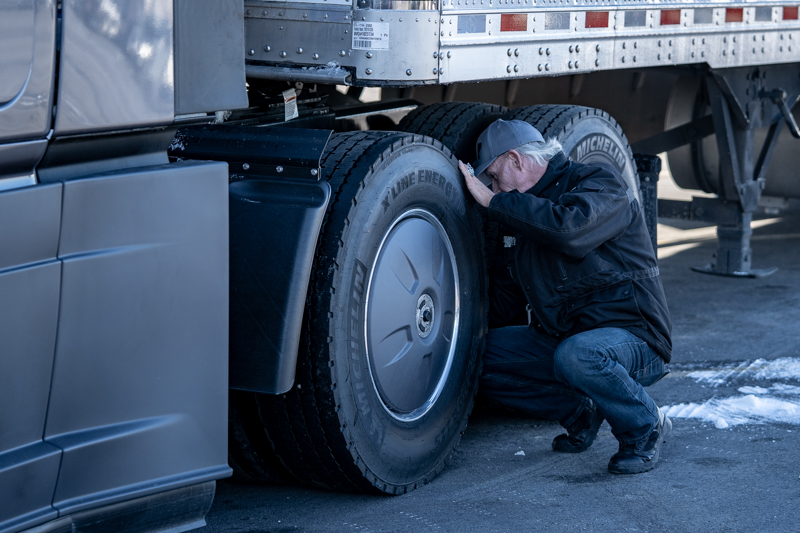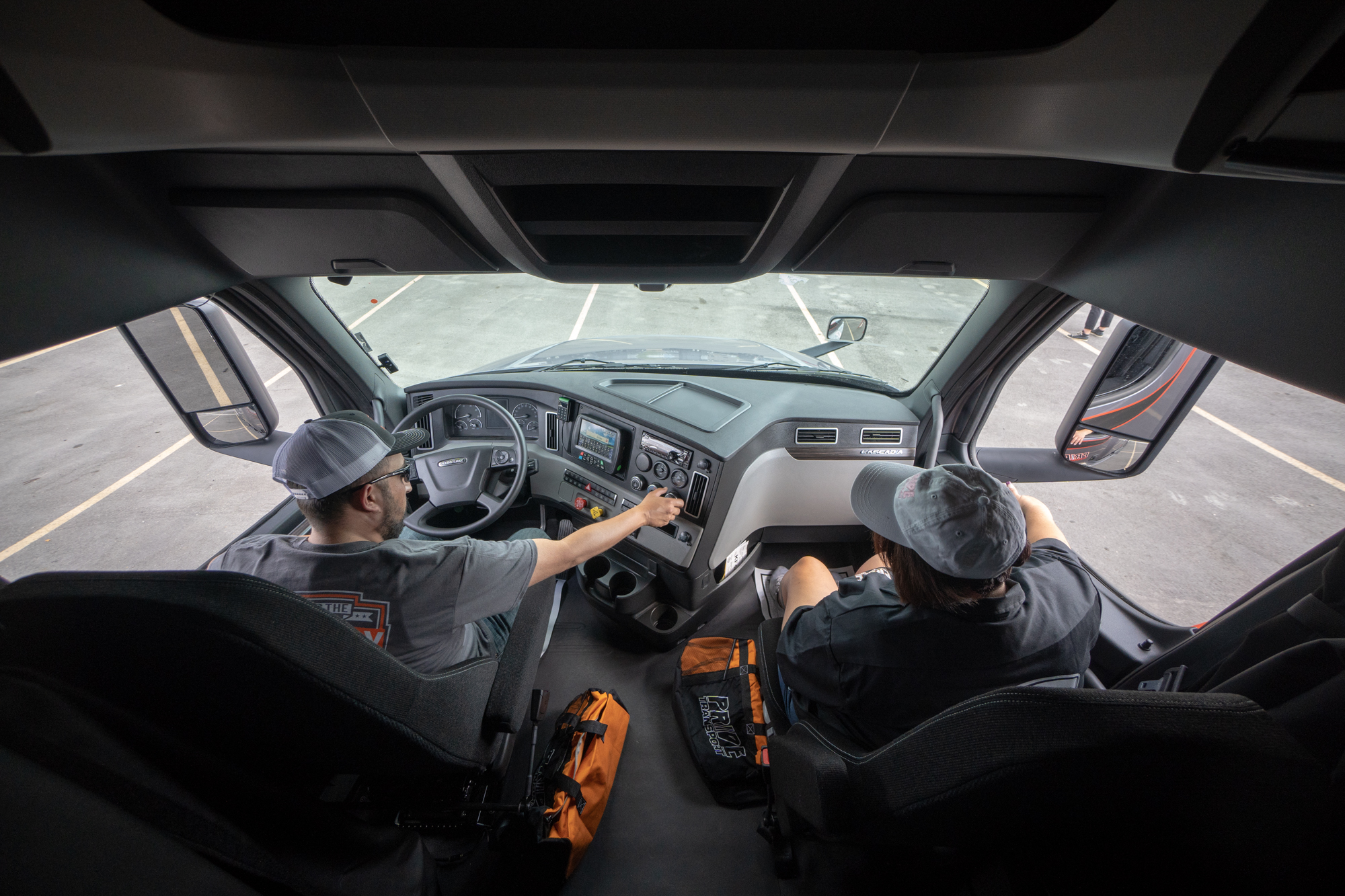by Pride Transport | May 15, 2024
Picture this: You’re hauling a heavy load while climbing a long uphill stretch of highway, using as much power as necessary to make the climb. You crest the hill and lay off the throttle, but the truck needs more time to slow down. With four full lanes of traffic stretching out ahead, you’re going to need more than just the truck’s service brakes in order to safely drive alongside the cars around you.
In this scenario, a truck driver needs to use Jake brakes to ensure their own safety and the safety of the driving public. In this article, we’ll cover what you need to know about Jake brakes, including what they are, how they work, and best practices for using them.
Jake Brakes: What They Are and Why Drivers Use Them
“Jake brake” is a nickname given to compression release engine brakes. The nickname most likely references the company that first manufactured compression brakes, Jacobs Vehicle Systems. All of the other names focus on the mechanics of how the part operates, and any of the following terms can be used interchangeably to refer to Jake brakes: “compression release brake”, “compression brake”, “decompression brake”.
The primary job of Jake brakes is to help slow down trucks without exclusively relying on service brakes. Whether they’re fully loaded with freight or not, semi trucks are extremely heavy and can be hard to handle in certain situations. Jake brakes are essentially a complimentary tool to the truck’s braking system that can be used alongside service brakes in specific situations. They offer a boost of braking power when quick deceleration is most critical, such as driving on steep declines or in heavy highway traffic.
Jake brakes aren’t a substitute for service brakes and should be used to supplement the truck’s service brakes. In everyday driving situations where truck drivers are operating their vehicles in accordance with posted speed limits, drivers can rely on their standard brakes to help them slowly reduce their speed and come to a complete stop. Depending on how often they’re used and under what conditions, brakes might need to be replaced every 100,000 miles, but some trucks could need new brakes as soon as every 50,000 or 70,000 miles. Jake brakes take on some of the heavy lifting and help to protect service brakes from extreme amounts of wear.

How Does a Jake Brake Work?
Jake brakes are integrated into the actual engine and change how the engine’s exhaust valves work. When in normal operation, a truck’s diesel engine works like this:
- Intake: Air enters the engine via the intake valve, and the engine cylinder fills with air.
- Compression: The air is compressed at high pressure.
- Expansion: Air expands and pushes the piston down. This directs energy back to the engine.
- Exhaust: The piston raises up and pushes air through the exhaust valve and out of the truck.
With a Jake brake, the exhaust valve opens up near the end of the compression stage and delivers less energy (in the form of air) back to the engine. The buildup of compressed air is what slows the vehicle down, even if the service brakes aren’t in use.
Jacobs Vehicle Systems advises drivers to remember the following three steps to engage their Jake brakes:
- Switch: Set the switch to the appropriate load setting. The heavier the load you’re hauling, the more braking power you’ll need. Most systems range from 3 (the highest power) to 1 (the lowest).
- Clutch: Release the clutch pedal to disengage the transmission.
- Throttle: Remove your foot from the throttle. Laying off the throttle kickstarts the Jake brake.
These steps essentially convert the engine from a “power-producing diesel engine into a power-absorbing air compressor,” according to Jacobs. Again, it’s important to remember that Jake brakes are meant to slow the vehicle and should be used in conjunction with service brakes to safely bring the truck to a complete stop.
Scenarios When Jake Brakes Are Appropriate
Jake brakes are designed to assist truck drivers in specific driving scenarios where they might need additional control over their vehicles. For example, Jake brakes are helpful in slowing down vehicles in heavy traffic, especially if the flow of traffic becomes more stop-and-go. Instead of repeatedly slamming on the brakes, drivers can better control the truck’s speed by employing the Jake brake.
Traveling downhill is the most common scenario for using Jake brakes. Trucks in general require a lot of power to drive uphill, and they take even more if they’re transporting full loads or heavy freight. Once on the downhill, drivers must be able to control their vehicles, and Jake brakes offer more control than simply coasting or relying on service brakes alone. Steep downhills are when brakes are most prone to giving out, which is another reason for using Jake brakes: They offer an extra safety measure in case of brake failure and truck escape ramps aren’t present.
OTR drivers in particular should learn how to properly use Jake brakes because they’re among the most likely to drive over different terrains, including mountainous regions.
Observing engine braking limitations
Jake brakes are typically described as making a loud growling or jackhammer-like sound when in use. The noise isn’t as noticeable in a wide-open highway setting due to the noise coming from all of the other vehicles. However, the sound from Jake brakes is often more apparent in residential areas, and can be more apparent if the vehicle isn’t equipped with an appropriate muffler.
The Jake brake’s sound is the foundation for many posted engine braking limitations in several states, cities, and townships. (The act of using a Jake brake is called engine braking.) Just as they need to follow traffic laws in whichever state they’re driving, truck drivers need to be aware of engine braking laws and limitations as well.
Pride Transport’s Focus on Safety
Driver safety is extremely important to our team at Pride Transport. Our trucks are equipped with the latest safety features and technology, and our expert maintenance technicians ensure that every vehicle is road-ready before every trip. If you’re looking for an opportunity to begin to further your driving career, check out the Pride Transport job board today!